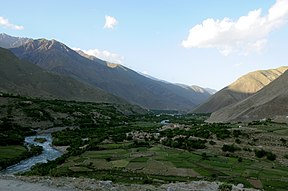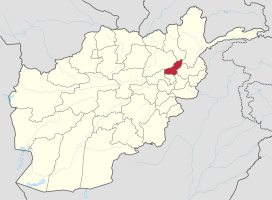Panjshir Valley
This article needs to be updated. (August 2021) |
| Panjshir Valley | |
|---|---|
 A view of Afghanistan's Panjshir Valley | |
 Map of Afghanistan with Panjshir highlighted |
The Panjshir Valley (also spelled Panjsheer or Panjsher; Pashto/Dari: درهٔ پنجشير – Dare-ye Panjšēr; literally Valley of the Five Lions) is a valley in north-central Afghanistan, 150 kilometres (93 mi) north of Kabul, near the Hindu Kush mountain range.[1] It is divided by the Panjshir River. The valley is home to more than 100,000 people, including Afghanistan's largest concentration of ethnic Tajiks.[2] In April 2004, it became the heart of the new Panjshir Province, having previously been part of Parwan Province.[3]
History

It was the site of the Panjshir offensives fought by the Democratic Republic of Afghanistan and the Soviets against the mujahideen during the Soviet–Afghan War from 1980 to 1985, when local commander Ahmad Shah Massoud successfully defended the valley from being taken.
The valley again witnessed renewed fighting during the 1996–2001 civil war between the Taliban and the Northern Alliance under the command of Massoud, where he again defended it from being overrun by the Taliban.[4] The Panjshir Valley was considered one of Afghanistan's safest regions during the era of the ISAF-backed government[5] and in late August 2021 became the main bastion of resistance to the Taliban in Afghanistan.[6][7][8] The Taliban announced that hundreds of fighters were headed towards the valley on 22 August 2021.[9]
"Former Vice President Amrullah Saleh and Ahmad Massoud, son of former anti-Soviet Mujahideen commander Ahmad Shah Massoud, have vowed to resist the Taliban from Panjshir, which repelled both Soviet forces and the Taliban in the 1980s and 1990s."[10] The Alliance has claimed to "Retake Districts in Northeast Afghanistan" [11]on August 22nd led by former military, special forces, police and more. The Biden administration has not publicly answered the plea made by Ahmad Massoud in a op-ed in The Washington Post for help restocking the anti-Taliban forces with supplies.[12]
Economy and natural resources

The Panjshir Valley has the potential to become a major centre of emerald mining. As early as the 1st century AD, Pliny the Elder commented on gemstones from the region.[13] In the Middle Ages, Panjshir was famed for its silver mining and the Saffarids and Samanids minted their coins there.[14] As of 1985, emeralds upwards of 190 carats (38 g) had been found in Panjshir, reported to rival in quality the finest crystals of the Muzo mine in Colombia.[13] American reconstruction efforts in Afghanistan sparked a development boom in the valley with the construction of new modern roads and a new radio tower that allows valley residents to pick up radio signals from the Afghan capital, Kabul.[15] The valley has the potential of being an energy hub for Afghanistan, through construction of several hydroelectric dams. Rewat locality could be the site of the first dam. The valley could make the capital region power self-reliant.
The Panjshir has always been an important highway. Nearly 100 kilometres (62 mi) long, it leads to two passes over the Hindu Kush – the Khawak Pass (3,848 m) leading to Afghanistan's northern plains, and the Anjuman Pass (4,430 m) that crosses into Badakhshan – used by the armies of Alexander the Great and Timur.
A 10-turbine wind farm was built in Panjshir Valley in April 2008.[16]
References
- ^ "Afghanistan gets rid of heavy arms in Panjshir". Xinhua. 2005-03-06. Archived from the original on 2006-10-16. Retrieved 2006-11-22.
- ^ "Afghanistan". Library of Congress Country Studies. Library of Congress. 1997. Retrieved 2006-11-19.
- ^ American Forces Press Service (5 July 2006). "New Afghan Road Offers Gateway to Optimism". archive.defense.gov. U.S. Department of Defense. Retrieved 16 August 2017.
- ^ Junger, Sebastian. "Massoud's Last Conquest". Vanity Fair.
- ^ "Foreign kayakers surprise Afghans in the Panjshir Valley". The National. August 2, 2016.
- ^ "As Taliban takes over, one Afghan province is still standing strong – Here's the story of Ahmad Shah Massoud and his bastion Panjshir". Free Press Journal. Retrieved 2021-08-17.
- ^ "Home". Northern Alliance: Fighting for a Free Afghanistan. Friends of the Northern Alliance. Retrieved 20 August 2021.
- ^ "'Panjshir stands strong': Afghanistan's last holdout against the Taliban". the Guardian. 2021-08-18. Retrieved 2021-08-20.
- ^ "AFP News Agency". Twitter. Retrieved 2021-08-22.
{{cite web}}: CS1 maint: url-status (link) - ^ https://www.usnews.com/news/world/articles/2021-08-21/anti-taliban-forces-say-theyve-taken-three-districts-in-afghanistans-north
- ^ https://news.antiwar.com/2021/08/22/anti-taliban-force-retakes-districts-in-northeast-afghanistan/
- ^ https://www.washingtonpost.com/opinions/2021/08/18/mujahideen-resistance-taliban-ahmad-massoud/
- ^ a b Bowersox, Gary; Lawrence W. Snee; Eugene E. Foord; Robert R. Seal II (1991). "Emeralds of the Panjshir Valley, Afghanistan". Gems and Gemology. Spring. Gemological Society of America: 26–39.
- ^ "Pandjhir". Encyclopaedia of Islam (CD-ROM v. 1.0 ed.). Leiden, The Netherlands: Koninklijke Brill NV. 1999.
- ^ Anderson, John Ward (2007-09-28). "A Haven of Prosperity in Afghanistan: U.S. Building Effort Blooms in Panjshir". The Washington Post. p. A11. Retrieved 2007-10-09.
- ^ "Power to the People: Getting 'off the grid'". EcoBob. 2008-07-16. Archived from the original on 2009-02-23. Retrieved 2010-01-10.
{{cite journal}}: Cite journal requires|journal=(help)
External links
- Where the Sun Rises: Afghanistan (video Sept. 1, 2017)
- Photographs from the Panjshir Province
